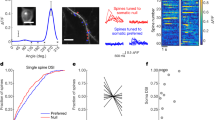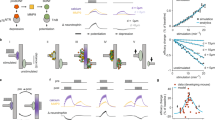Abstract
In the companion paper we presented extended simulations showing that the recently observed spike-timing dependent synaptic plasticity can explain the development of simple cell direction selectivity (DS) when simultaneously modifying the synaptic strength and the degree of synaptic depression. Here we estimate the spatial shift of the simple cell receptive field (RF) induced by the long-term synaptic plasticity, and the temporal phase advance caused by the short-term synaptic depression in response to drifting grating stimuli. The analytical expressions for this spatial shift and temporal phase advance lead to a qualitative reproduction of the frequency tuning curves of non-directional and directional simple cells. In agreement with in vivo recordings, the acquired DS is strongest for test gratings with a temporal frequency around 1–4 Hz. In our model this best frequency is determined by the width of the learning function and the time course of depression, but not by the temporal frequency of the ‘training’ stimuli. The analysis further reveals the instability of the initially symmetric RF, and formally explains why direction selectivity develops from a non-directional cell in a natural, directionally unbiased stimulation scenario.
Similar content being viewed by others
References
Albrecht D, Farrar S, Hamilton, D (1984) Spatial contrast adaptation characteristics of neurones recorded in the cat’s visual cortex. J. Physiol. (London) 347: 713-739.
Bi G, Poo M (2001) Synaptic modification by correlated activity: Hebb’s postulate revisited. Annu. Rev. Neurosci. 24: 139-166.
Buchs N, Senn W (2002) Spike-based synaptic plasticity and the emergence of direction selective simple cells: Simulations results. J. Computational Neuroscience 13(3): 167-186.
Carandini M, Heeger D, Movshon J (1997) Linearity and normalization in simple cells of the macaque primary visual cortex. Journal of Neuroscience 17(21): 8621-8644.
Carandini M, Heeger D, Senn W (2002) A synaptic explanation of suppression in visual cortex. J. Neuroscience 22(22): 10053-10065.
Chance F, Nelson S, Abbott L (1998) Synaptic depression and the temporal response characteristics of V1 cells. J. Neuroscience 18(12): 4785-4799.
Freeman T, Durand S, Kiper D, Carandini M (2002) Suppression without inhibition in visual cortex. Neuron 35: 759-771.
Fu YX, Djupsund K, Gao H, Hayolen B, Shen K, Dan Y (2002) Temporal specifity in the cortical plasticity of visual space representation. Science 296(5575): 1999-2003.
Hubel D, Wiesel T (1962) Receptive fields, binocular interaction and functional architecture in the cat’s visuals cortex. J. Physiol. (London) 160: 106-154.
Humphrey A, Saul A (1998) Strobe rearing reduces direction selectivity in area 17 by altering spatiotemporal receptive-field structure. J. Neuroscience 80: 2991-3004.
Jagadeesh B, Wheat H, Ferster D (1993) Linearity of summation of synaptic potentials underlying direction selectivity in simple cells of the cat visual cortex. Science 262: 1901-1904.
Maex R, Orban G(1996) Model circuit of spiking neurons generating directional selectivity in simple cells. J. Neurophysiol 75: 1515-1545.
Markram H, Tsodyks M (1996) Redistribution of synaptic efficacy between neocortical pyramidal neurons. Nature 382: 807-810.
Morrone M, Burr D, Maffei L (1982) Functional implications of cross-orientation inhibition of cortical visual cells. I. Neurophysiological evidence. Proc. R. Soc. Lon. B 216: 335-354.
Ohzawa I, Sclar G, Freeman R (1985) Contrast gain control in the cat’s visual system. J. Neurophysiol. 54: 651-667.
Reid R, Soodak R, Shapley R (1987) Linear mechanisms of directional selectivity in simple cells of cat striate cortex. Proc. Natl. Acad. Sci. USA 84(23): 8740-8744.
Reid R, Soodak R, Shapley R (1991) Directional selectivity and spatiotemporal structure of receptive fields of simple cells in cat striate cortex. J. Neurophysiol. 66(2): 505-529.
Saul A, Humphrey A(1990) Spatial and temporal response properties of lagged and nonlagged cells in cat lateral geniculate nucleus. J. Neurophysiol. 64: 206-224.
Saul A, Humphrey A (1992) Temporal frequency tuning of direction selectivity in cat visual cortex. Vis. Neurosci. 8: 365-372.
Senn W, Tsodyks M, Markram H (2001) An algorithm for modifying neurotransmitter release probability based on pre-and postsynaptic spike timing. Neural Computation 13(1): 35-68.
Senn W (2002) Beyond spike-timing: The role of nonlinear synaptic plasticity and unreliable synapses. Biol. Cybernetics 87: 344-355.
Shapley R (1996) Linearity and non-linearity in cortical receptive field. Ciba Found Symp 184: 71-87.
Stratford K, Tarczy-Hornoch K, Martin K, Baninster N, Jack J (1996) Excitatory synaptic inputs to spiny stellate cells in cat visual cortex. Nature 382: 258-261.
Yao H, Dan Y (2001) Stimulus timing-dependent plasticity in cortical processing of orientation. Neuron 32: 315-323.
Author information
Authors and Affiliations
Rights and permissions
About this article
Cite this article
Senn, W., Buchs, N. Spike-Based Synaptic Plasticity and the Emergence of Direction Selective Simple Cells: Mathematical Analysis. J Comput Neurosci 14, 119–138 (2003). https://doi.org/10.1023/A:1021935100586
Issue Date:
DOI: https://doi.org/10.1023/A:1021935100586




